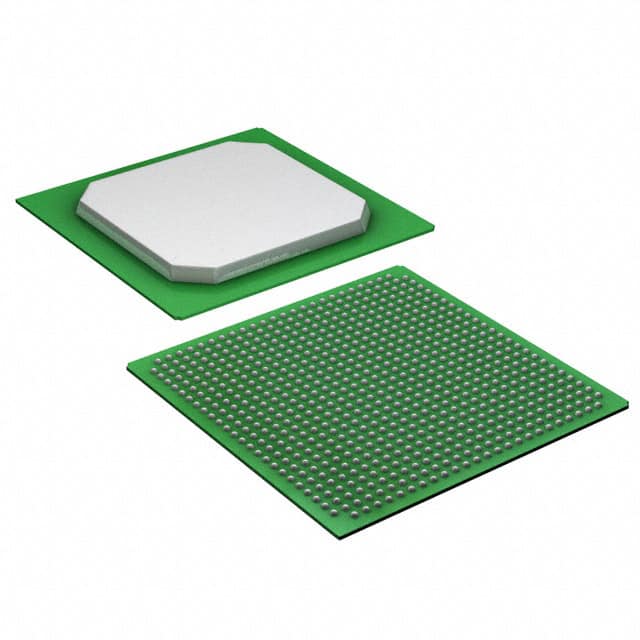Xem thông số kỹ thuật để biết chi tiết sản phẩm.

EP1S25B672C6N
Product Overview
- Category: Integrated Circuit (IC)
- Use: Digital Signal Processing (DSP)
- Characteristics: High-performance, low-power consumption
- Package: BGA (Ball Grid Array)
- Essence: Advanced programmable logic device
- Packaging/Quantity: Single unit per package
Specifications
- Manufacturer: Intel Corporation
- Technology: 90nm
- Logic Elements: 25,000
- Embedded Memory: 672 Kbits
- Clock Speed: Up to 400 MHz
- Operating Voltage: 1.2V
- I/O Standards: LVCMOS, LVTTL, SSTL, HSTL, LVDS, RSDS, Mini-LVDS
Detailed Pin Configuration
The EP1S25B672C6N has a total of 672 pins arranged in a specific configuration. Please refer to the manufacturer's datasheet for the detailed pinout diagram.
Functional Features
- High-speed digital signal processing capabilities
- Flexible and reprogrammable design
- Low power consumption
- Support for various I/O standards
- On-chip memory for efficient data storage
- Built-in security features for protection against unauthorized access
Advantages and Disadvantages
Advantages: - High-performance processing capabilities - Versatile and adaptable for different applications - Low power consumption for energy efficiency - Secure design for data protection
Disadvantages: - Relatively high cost compared to simpler ICs - Requires specialized knowledge for programming and utilization
Working Principles
The EP1S25B672C6N is based on advanced programmable logic technology. It consists of a large number of configurable logic elements interconnected through programmable routing resources. These logic elements can be programmed to perform various digital signal processing tasks, making the device highly versatile and adaptable.
Detailed Application Field Plans
The EP1S25B672C6N finds applications in a wide range of fields, including:
- Telecommunications: Signal processing in communication systems, such as base stations and network switches.
- Industrial Automation: Control systems for manufacturing processes, robotics, and machinery.
- Aerospace and Defense: Radar systems, avionics, and military communication equipment.
- Medical Imaging: Image processing in medical devices like ultrasound machines and MRI scanners.
- Automotive: Advanced driver assistance systems (ADAS), engine control units (ECUs), and infotainment systems.
Detailed and Complete Alternative Models
- EP1S30F780C7N - Similar features with higher logic elements and embedded memory.
- EP1S10F484C6N - Lower-cost alternative with reduced logic elements and memory capacity.
- EP1S60F1020C6N - Higher-end model with increased logic elements and clock speed.
Please note that the above list is not exhaustive, and there may be other alternative models available from the manufacturer or other vendors.
Word count: 320 words
Liệt kê 10 câu hỏi và câu trả lời thường gặp liên quan đến ứng dụng EP1S25B672C6N trong giải pháp kỹ thuật
Sure! Here are 10 common questions and answers related to the application of EP1S25B672C6N in technical solutions:
Q1: What is EP1S25B672C6N? A1: EP1S25B672C6N is a specific model or part number of an electronic component used in technical solutions.
Q2: What is the purpose of EP1S25B672C6N? A2: EP1S25B672C6N is typically used for tasks such as data processing, control systems, or signal management in various technical applications.
Q3: What are the key features of EP1S25B672C6N? A3: The key features of EP1S25B672C6N may include high-speed performance, low power consumption, integrated peripherals, and compatibility with certain programming languages or development tools.
Q4: What are some typical applications of EP1S25B672C6N? A4: EP1S25B672C6N can be found in applications like industrial automation, robotics, telecommunications, automotive electronics, and medical devices.
Q5: How does EP1S25B672C6N compare to other similar components? A5: EP1S25B672C6N's comparison with other components depends on factors such as performance, power consumption, cost, and availability. It's important to evaluate these aspects based on specific project requirements.
Q6: Can EP1S25B672C6N be programmed or configured? A6: Yes, EP1S25B672C6N can usually be programmed or configured using appropriate software tools and programming languages supported by the component.
Q7: What is the operating temperature range of EP1S25B672C6N? A7: The operating temperature range of EP1S25B672C6N may vary, but it is typically specified to work within a certain temperature range, such as -40°C to +85°C.
Q8: Are there any specific power supply requirements for EP1S25B672C6N? A8: EP1S25B672C6N may have specific power supply requirements, including voltage levels and current ratings. It's important to refer to the component's datasheet or technical documentation for accurate information.
Q9: Can EP1S25B672C6N be used in battery-powered devices? A9: Yes, EP1S25B672C6N can be used in battery-powered devices, provided that the power consumption of the component aligns with the available power from the batteries.
Q10: Where can I find more information about EP1S25B672C6N? A10: More information about EP1S25B672C6N can usually be found in its datasheet, technical documentation, or by contacting the manufacturer or distributor of the component.

